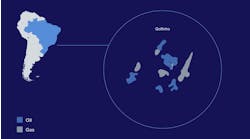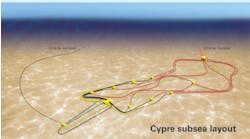Bev EdwardsWhat is deep water anyway? Back in the 1960s we designed production platforms for two or three hundred feet of water with 3D computer analysis programs, and we thought that we were really stepping out as far as we dared go. Then in the late 1970s, I remember standing on the stern of a big lay barge and watching a 10 inch pipeline that we had designed go down the stinger into the Gulf of Mexico in 812 feet of water. This had to be the outer limit. At the same time we were politely showing view graphics in the conference room of proposed Floating Production Storage and Offloading (FPSO) systems for deepwater fields offshore West Africa and prospects in the Baltimore Canyon. There were questions after the presentation, but no one was ready to risk buying one. A few days ago, I looked at an old FPSO study that we did in 1977, and we are building them now very much as we had planned. Each step deeper was a leap of faith.
FMC SOFEC
Now we sit and look at worldwide supply and demand curves for crude oil, and we realize that we will gradually be drawn farther offshore in search of future reserves. Perhaps at some water depth we will reach a technical or economic limit, and move towards alternative energy sources. We are nowhere near that point yet. Suddenly everyone wants an FPSO. The phone rings often with requests on an FPSO for a particular location. How much will it cost, and how soon could you build? Have you got a rental unit in stock ready to go? What do we see as the future of floating production?
The technical changes are exciting. Mooring systems will be lighter, stronger and more cost effective with synthetic fiber rope taking the place of wire rope and chain. Taught synthetic polyester mooring lines are already appearing on AUTOCAD screens, attached to FPSOs. They produce less vertical load on the mooring system. Dynamic positioning system thrusters may also assist in reducing mooring line loads. We have relied on high pressure flexible composite material risers to bring well fluids to the ocean surface. Now titanium steel catenary risers with high strength to weight ratios are being analyzed, designed and tested. Some of these risers may also function as moorings. Virtual reality is the buzz word around the research and development group now. We are reaching out with greater computer power to create a Virtual Reality Model Basin to exceed the present 10 meter water depth limit on existing wave basins. I have watched videos of Computational Fluid Dynamics (CFD) where computer generated green water waves come over the bow of a turret moored FPSO in a 100 year storm event. This computer power blow you away. 3D seismic is changing exploration dynamics, but the problem of what to do with associated gas on an FPSO remains. It will surely be solved with light weight high efficiency LNG and LPG plants in the hull, to stop offshore gas flaring. A new LPG FSO will be in place in Nigeria next year.
Commercial changes are already occurring in the FPSO market as production contracting takes its place. Strategic alliances of engineering firms, hardware suppliers, installers and operators are forming to furnish a total production contracting service to an oil company. They will furnish engineering, subsea wellheads, trees, controls, risers, the FPSO, operating crews, and maintenance. The lease holder/field operator will manage the reservoir and may contract out the production service on a competitive basis, with payment in cash or oil. The risk/reward baton will be handed to the contractor, with incentives for production goals.
Partnerships between oil producing companies and specialty contractors will flourish. Capital risks are reduced with mobile offshore production systems that will produce many different fields in the life of the equipment. The population of new build and converted FPSOs will increase dramatically as we pass into the next century. Hang on for the ride.
This page reflects viewpoints on the political, economic, cultural, technological, and environmental issues that will shape the future of our industry. Offshore Magazine invites you to share your thoughts. Send your manuscript to "Beyond the Horizon",Offshore Magazine, Box 1941, Houston, TX 77251 USA. Manuscripts will not be returned.
Copyright 1996 Offshore. All Rights Reserved.


